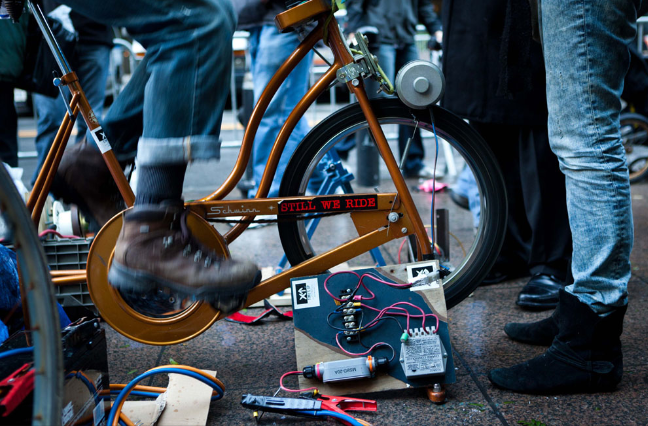Google “What do the occupiers want?” and you will come up with something like 17 million hits in les than 0.1 seconds. Everyone, apparently, wants to know. The problem, of course, is that just as with Freud’s question “what do women want?,” the very inquiry is tongue-in-cheek as it presumes there is no answer that can be reasonably accommodated under the prevailing regime of logic that animates it. For Freud, of course, that was the law of the Father, and for those who challenge the Wall Street occupiers it is the logic of the market. And in each case it presumes something like a rational, oral/verbal response.
Lacking a spokesperson or unified voice however does not mean that the occupiers are without a sense of purpose or desire however inchoate it might seem to be. One simply has to observe what they are doing. That is, rather than to listen to what they say they want, one needs to see how they conduct themselves. And when one substitutes sight for sound—photographs for sound bytes—it begins to become clear on par that this is a humane, ordered, and indeed rational movement however fragmented it might be in its particular instantiations from one city or locale to the next.
Yes, it is true that the Oakland anarchists challenged this characterization in ways that give the illusion of credence to Eric Cantor’s depiction of the occupiers writ-large and across the nation as an unruly mob, but notwithstanding all of the coverage that the mainstream media gave to such—remember, “if it bleeds it leads”—the Oakland disturbances remain the aberration. The clear exception to the rule. And the rule has been the somewhat ordered development of tent cities that have been attentive to problems of nutrition, sanitation, and even health care.
Most of the photographs that we see in the mainstream media feature the occupiers in actual protest mode, holding up signs, engaging in street theater, marching or holding hands in solidarity, staring down the police, and so on. And when we see them encamped they are usually sitting on the ground or on sleeping bags looking somewhat bored. But occasionally photographs slip through that show the encampments themselves, ordered and fairly clean given the circumstances (except in those places, such as Denver, where the police rousted the tent cities and left them in shambles); or people lining up at food tables, serving and being served, and so on. And sometimes we see images such as the one above that show the members of the community working altogether rationally to sustain itself in the face of adversity. According to the caption this photograph was taken in Zuccotti park and it shows the “protestors” charging high-capacity boat batteries that have been retrofitted with small generators after the police confiscated their gas powered generators citing safety concerns. Adapt and adopt seems to be the rule.
I like this photograph in large part because it features the foot rather than the face, or more to the point, it features the shoe. Lots of shoes, actually, including the work boot, a black oxford, and an ankle boot. There may even be a sneaker in the background, though it is hard to be certain. But in any case, the emphasis on shoe and style calls attention to the pluralist world that is being organized and brought together. Race, age, and even class are largely effaced, while perhaps gender maintains some presence (but even a woman can wear a work boot or ride a cycle!). And so what we get is not a sense of the individuals involved, who remain altogether anonymous and unspoken, but the articulation of social types all seemingly working in tandem towards a common goal. Indeed, the photograph is in some measure an allegory for the body politic. But instead of an organic, idealized, or essentialist political body marked by the “official spokesperson,” we see a body politic adapted to the conditions of contemporary political life: a body politic that is fragmented, realistic, and provisional. In short, the photograph shows a conception of public life that is no longer whole—in the most traditional sense—but is nevertheless active and engaged and in its own way successful. It is, in short, an image of a pluribus without an unum, a plurality that need not be be reduced to a stultifying One. A public that is animated by common needs and goals without ignoring—or being reduced to—stylized differences.
What do the Wall Street occupiers want? It is hard to say. But then again, one really just needs to look in order to begin to figure it out.
Photo Credit: John Minchillo/AP Photo

Discussion